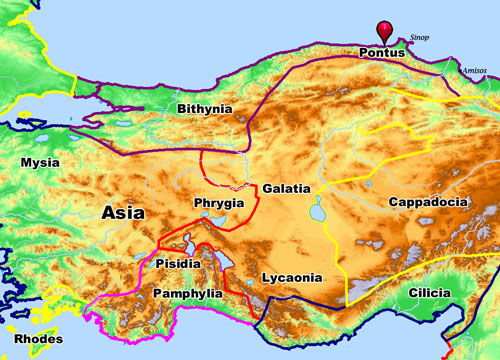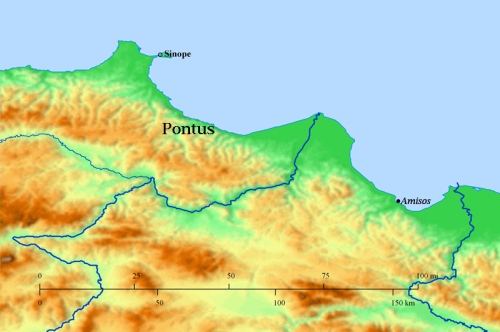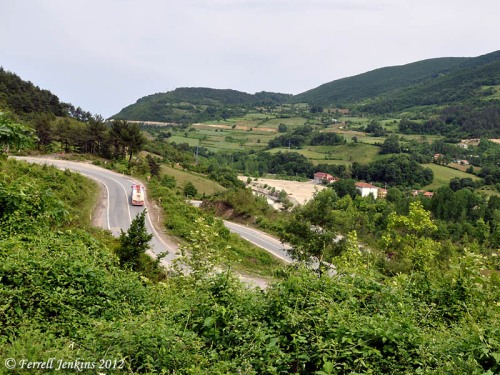'via Blog this'
The delivery of Peter’s Epistles
When I began to write about Pontus, the Black Sea Coast, and the cities of Samsun and Sinop, it was primarily to discuss the address of the Apostle Peter’s epistles.
Peter, an apostle of Jesus Christ, To those who are elect exiles of the Dispersion in Pontus, Galatia, Cappadocia, Asia, and Bithynia, (1 Peter 1:1 ESV)
I assume, based on 2 Peter 3:1, that both of Peter’s epistles were written to the same Christians.
This is now the second letter that I am writing to you, beloved. In both of them I am stirring up your sincere mind by way of reminder, (2 Peter 3:1 ESV)
The map below shows the larger portion of Asia Minor. Note the order of the provinces in Peter’s address: Pontus, Galatia, Cappadocia, Asia, and Bithynia.
We know it was common for the New Testament letters to be carried from the place of writing to the those addressed by personal, trusted messengers.
- Tychicus was the bearer of Ephesians and Colossians (Ephesians 6:21; Colossians 4:7).
- Letters were sometimes sent from one church to another (Colossians 4:16).
- It is often pointed out that the order of the letters to seven churches of Asia follow a typical circuit along known travel routes: Ephesus, Smyrna, Pergamum, Thyatira, Sardis, Philadelphia, and Laodicea (Revelation 1:11; 2-3).
We may raise questions concerning Peter’s epistles. Let us assume for the moment that Peter wrote from Rome. This is my understanding of 1 Peter 5:13. If the bearer of 1 Peter began his delivery route in Pontus, how did he get there? Was it overland or by sea?
Understanding the terrain. Once we understand something about the terrain the answer becomes obvious. Coming from the west it would be much easier to go to Pontus by sea than by land. A first stop might be at the city of Amastis (modern Amasra, west of Sinop). The next stop would be Sinop. Neither of these cities would provide a good place to begin an inland journey going through the named provinces. The ideal beginning point would be Amisos (modern Samsun). Mark Wilson writes about Amastris:
A coasting vessel carrying Peter’s messenger would certainly have stopped here. Amastris has been suggested as an entry point for Peter’s letter to the cities of inner Pontus and northern Galatia, but the road to the interior was difficult. It is more probable that the messenger continued by sea to Sinope and Amisus. (Biblical Turkey, 337).
When you look at a map showing topographical detail you see that both Bithynia and Pontus are not very wide (north to south), and that most of that width is mountainous. Some areas, in fact, have no coastal roads. Such is still true of the region east of Sinope.
The distance between Samsun and Sinop is barely 100 miles. Leaving Samsun we had good road for about the first 50 miles. After that the road was mountainous and much construction work was underway. Often we were driving high above the Black Sea even when we could see it. We had expected to make the drive in two hours in our good rental car. It took us three hours. Notice this hair pin section of the two lane road.
Both Sinop and Samsun were significant in the life of Mustafa Kemal Atatürk, the founder of the Republic of Turkey. The following sentence shows that both towns were more easily reached by sea even as recently as a century ago.
Atatürk came to Sinop on the ship Bandirma on 18 May 1919. As there was no road between Sinop and Samsun at that time, he continued his journey by sea. (McDonagh, Blue Guide: Turkey; Emphasis added).
Wilson comments on the importance of Amisus (Samsun) as a port of entry into Asia Minor.
Amisus was at the northern terminus of the main road that ran across Asia Minor to Tarsus. Peter’s messenger undoubtedly embarked at Amisus and initially made his way south along this route. (Biblical Turkey, 340)
The photo below was made from the highway east of Sinop. I hope that this, and the following photo, will help to illustrate the difficulty of travel in the region.
These photos and the information we have provided show that travel by sea would be much easier than travel by land, and that Sinop would not have been a good place to begin an inland journey. Leon made the following photo of the road and the mountains east of Sinop. This was one of the rare places where a vehicle could pull off road.
A note about spelling. Some of the towns we are writing about have an ancient name and a different modern name. In the case of Sinop, it is spelled Sinope in older sources.






No comments:
Post a Comment